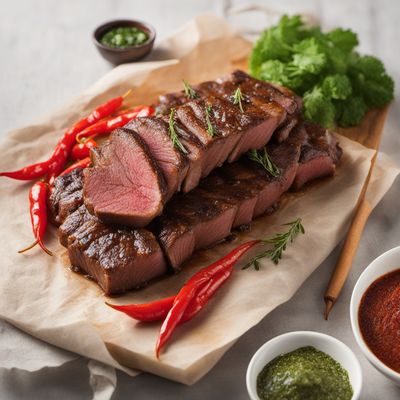
Ingredient
Andean yam beans
The Versatile Andean Treasure
Andean yam beans have a rough, brown skin and crisp white flesh. They offer a refreshing and juicy texture, similar to that of an apple or water chestnut. The flavor is mild and slightly sweet, with hints of pear and cucumber. These tubers are often enjoyed raw or lightly cooked to preserve their crispness.
Origins and history
Andean yam beans, scientifically known as Pachyrhizus erosus, have a long history in Andean cuisine. Native to Mexico and Central America, they have been cultivated for thousands of years. Andean yam beans were highly valued by ancient civilizations for their nutritional value and versatility in cooking. They were used in various traditional dishes and even as a natural remedy for digestive issues.
Nutritional information
Andean yam beans are low in calories and fat, while providing a good amount of dietary fiber. They are also a good source of vitamin C and minerals like potassium and magnesium. These tubers offer a satisfying crunch and can be a healthy addition to your meals.
Allergens
There are no known allergens associated with Andean yam beans.
How to select
When selecting Andean yam beans, look for tubers that are firm and free from blemishes or soft spots. The skin should be intact and not wrinkled. Avoid yam beans that appear shriveled or have a moldy smell. Opt for smaller-sized tubers, as they tend to be sweeter and have a better texture.
Storage recommendations
To prolong the freshness of Andean yam beans, store them in a cool and dry place, away from direct sunlight. They can be kept at room temperature for up to a week. If you have cut or peeled yam beans, store them in the refrigerator in a sealed container to maintain their crispness.
How to produce
Andean yam beans can be grown in warm climates with well-drained soil. They require a long growing season and prefer full sun. Plant the seeds or seedlings in spring after the last frost and provide regular watering. Harvest the tubers when they reach maturity, usually around 4-6 months after planting.
Preparation tips
Andean yam beans can be enjoyed raw, sliced into sticks or rounds for a refreshing snack. They can also be added to salads, slaws, or stir-fries for a crunchy texture. Lightly cooking them in stir-fries or roasting them brings out their natural sweetness. Experiment with incorporating Andean yam beans into your favorite recipes to explore their versatility.
Culinary uses
Andean yam beans are commonly used in salads, slaws, stir-fries, and as a raw snack. They are particularly popular in Mexican and Central American cuisines, where they are valued for their unique texture and mild flavor.
Availability
Andean yam beans are commonly available in Mexico, Central America, and some parts of South America. They can also be found in specialty stores or international markets that offer Andean ingredients.
More ingredients from this category
Recipes using Andean yam beans » Browse all

Carimañola with a Twist
Savory Yuca Fritters: A Colombian Delight

Togolese Kalamperova Soup
Savory Togolese Delight: Kalamperova Soup with a Twist

Samoan Yuca Fritters
Tropical Delight: Samoan Yuca Fritters with a Twist

Chifa-style Beef Anticucho
Peruvian-Inspired Beef Skewers with a Chifa Twist

Peruvian-Inspired Spring Rolls
Andean Delight Spring Rolls

Gadazelili Khveli with a Twist: Ecuadorian Style
Savory Ecuadorian Spin on Gadazelili Khveli

Congolese-style Revolcado
Savory Congolese Pork Stew with Root Vegetables

Caribbean Spiced Goat Stew
Savory Caribbean Delight: Spiced Goat Stew

Buñuelos de Yuca with a Twist
Crispy Yuca Fritters: A Colombian Delight

Fettuccine con Salsa de Mantequilla y Parmesano
Delicioso Fettuccine Peruano con Salsa de Mantequilla y Parmesano

Tagliatelle al ragù alla Bolognese
Tagliatelle con salsa de carne a la Bolognesa

Emirati-inspired Carimañola with a Twist
Golden Delights: Emirati-inspired Carimañola with a Crunchy Twist